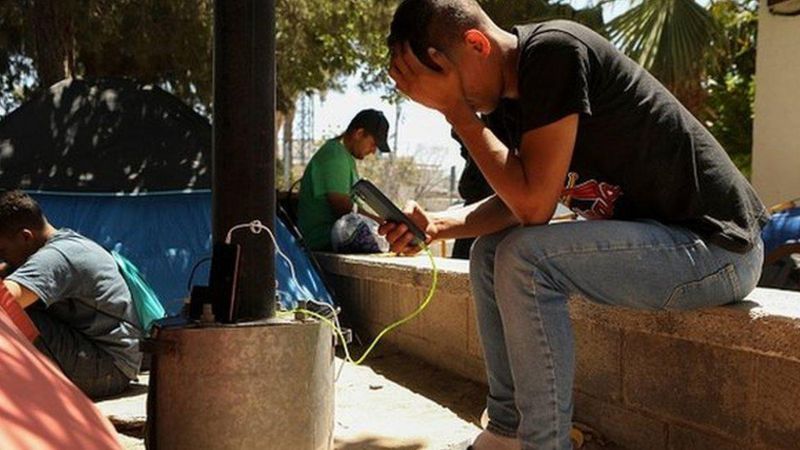
As they tread the muddy waters of the Rio Grande, a small group of smiling migrants look to the horizon: the end of their perilous journey to the US is just a few meters away.
At the top of the video is a message – “Crossing the river safely” – with the hashtag #SueñoAmericano. “Write to me and I’ll send you more information.” The video is one of hundreds circulating on social networks that promise migrants a new start in the US, cheaply and without problems. And although they seem innocent, and even friendly, experts warn that they are deceptive. “They are offering human trafficking,” says Ed Calderon, a former Mexican police officer who specializes in the illegal world of the border. “And they´re out there in the open.” Experts say these video clips – on platforms including TikTok, YouTube and WhatsApp – are the public face of a highly sophisticated multi-billion dollar industry. Taking advantage of the confusion caused by changes in US immigration policies, they spread misinformation and drive demand for their services.
The law of supply and demand
Business has increased after the so-called Title 42 expired on May 11th, a policy of the Donald Trump presidency that allowed the US to deport people quickly, without asylum hearings, with the justification of the coronavirus pandemic. The new approach seeks to promote legal roads, while imposing heavy penalties on those who cross illegally. US agents say that since Title 42 ended, immigration detentions have fallen 70%, as more people enter the country legally. However, the fact that the arrest numbers fall does not mean that the profits for criminal organizations that help migrants cross illegally also fall. “It’s like Christmas for these traffickers,” Calderón tells the BBC, adding that there is a perception among many migrants that effectively crossing the border without being stopped is more difficult. “It’s all because of propaganda, which helps them raise prices.” Calderón’s position is the same as that of Adam Isacson, an expert on migration and borders with the human rights organization Washington Office on Latin America. Isacston argues that the demand for the services of traffickers has surely increased after Title 42 “among those who want to enter the US without detection.” “If the numbers drop after a policy change, prices for migrant smuggling services undoubtedly go up,” he explains.
The modernization of human trafficking
Videos posted on social networks arrive in different ways and in some cases are far from subtle. Some are testimonials from apparently satisfied customers, supposedly speaking from secure sites or from the streets of American cities. “Here we are in New York City,” says the speaker with a Venezuelan accent in one of these videos as he walks down a Manhattan street. “I would like to thank my companions for helping me get here safely.” The text that accompanies the video, from a “travel agency”, asks those who see his case to send a message asking for help to get to the US without a visa. Others show camouflaged smugglers leading groups of migrants through difficult terrain, or using ladders to easily cross border barriers. Many promise door-to-door services from far flung parts of South America to final destinations in the US. Almost all of them either have a WhatsApp phone number or promise to give them more details – including pricing and payment plans – via private message.
The intrinsic secrecy of the industry means that there are no reliable statistics on how many migrants find their traffickers on the networks or which of the posts are real. Guadalupe Correa-Cabrera, an associate professor at George Mason University who investigates human smuggling organizations, says the networks allow criminals to create a “constant sense of urgency” among migrants. This can land migrants right into the hands of smugglers, even those who don’t contact them online. “Migrants are out of their comfort zone, and the journey can be horrible. There are many things that can occur in their psyche as well,” she said. “The smuggling networks understand that and work, organically, injecting disinformation to incentivize fear and make migrants try to achieve it however they can.”
Price range
Experts say prices for services can vary wdely and are often defined by what traffickers believe people can pay, either upfront or in future installments. US officials have warned that migrants who do not pay are often forced to work for cartels, often as prostitutes, drivers or mules. Others are simply kidnapped until all debts are paid, or their families in the US or wherever they come from are threatened. “It’s a huge industry and it’s a cartel industry,” says Calderón. “Smuggling people across the border is one of the businesses that generates the most money right now.”
Calderón estimates that even the most basic packages, which he describes as “we’ll see if we get there” trips, start at US$5,000 and US$8,000 per family of four starting from Mexico. Sources in the US and Mexican authorities estimate that typical prices are currently around US$15,000, reaching between US$50,000 and US$60,000 for migrants coming from outside of Latin America.
Disinformation based on business
The issue of disinformation on social networks has increasingly captured the attention of the authorities. Shortly before Title 42 came to an end, for example, US Homeland Security Secretary Alejandro Mayorkas warned potential migrants against falling for lies designed to “lure vulnerable people to the southern border.” Additionally, the Department of Homeland Security launched a “geotargeted” campaign on social platforms in Central and South America. The ads are designed to reach migrants on their mobile phones, and direct them to government-operated pages that clarify facts about US immigration policies, as well as warning of possible dangers. US officials told the BBC that the ads are still running even after recent policy changes.
For its part, TikTok said that it had a “zero tolerance” position towards human trafficking and that it had dedicated a “significant investment” to the search and removal of this type of content, in addition to the permanent blocking of accounts that promote it. The two videos that are mentioned in this story have already been removed, only to be replaced by others with similar content in a few moments.
Alex Pacheco was a supervisor with the US Customs and Border Patrol (CBP) for more than 20 years and says the rumors online are expected to continue to surface as traffickers are ready to exploit the anxieties that migrants have about the impact that US national news and policies have on what happens at the border. Pacheco believes this trend will become even more widespread as the US heads into the 2024 presidential election. “Everyone will always say that people need to cross now. Some people would have told you, for example, that prices were going to increase if you didn’t cross before Title 42”, says Pacheco. “Now, they will surely say that a new administration can arrive, that the president will not be Joe Biden or that the border will go back to the way it was in the previous administration… this all benefits the criminal organization.”
“That´s capitalism,” he concludes.
Original article by Bernd Debusmann Jr. at https://www.bbc.com/mundo/articles/c3g1lr4gezdo.amp
Translated by Schools for Chiapas.
